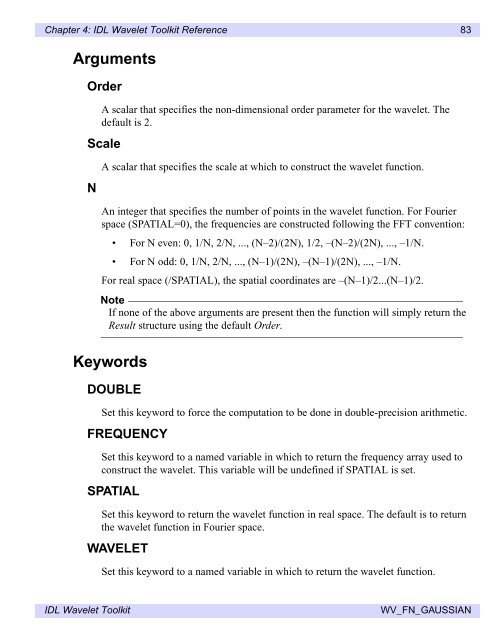IDL Wavelet Toolkit User's Guide
IDL Wavelet Toolkit User's Guide
IDL Wavelet Toolkit User's Guide
You also want an ePaper? Increase the reach of your titles
YUMPU automatically turns print PDFs into web optimized ePapers that Google loves.
Chapter 4: <strong>IDL</strong> <strong>Wavelet</strong> <strong>Toolkit</strong> Reference 83ArgumentsOrderA scalar that specifies the non-dimensional order parameter for the wavelet. Thedefault is 2.ScaleNA scalar that specifies the scale at which to construct the wavelet function.An integer that specifies the number of points in the wavelet function. For Fourierspace (SPATIAL=0), the frequencies are constructed following the FFT convention:• For N even: 0, 1/N, 2/N, ..., (N–2)/(2N), 1/2, –(N–2)/(2N), ..., –1/N.• For N odd: 0, 1/N, 2/N, ..., (N–1)/(2N), –(N–1)/(2N), ..., –1/N.For real space (/SPATIAL), the spatial coordinates are –(N–1)/2...(N–1)/2.NoteIf none of the above arguments are present then the function will simply return theResult structure using the default Order.KeywordsDOUBLESet this keyword to force the computation to be done in double-precision arithmetic.FREQUENCYSet this keyword to a named variable in which to return the frequency array used toconstruct the wavelet. This variable will be undefined if SPATIAL is set.SPATIALSet this keyword to return the wavelet function in real space. The default is to returnthe wavelet function in Fourier space.WAVELETSet this keyword to a named variable in which to return the wavelet function.<strong>IDL</strong> <strong>Wavelet</strong> <strong>Toolkit</strong>WV_FN_GAUSSIAN
















